John F. Karlik,*
University of California
Cooperative Extension
1031 S. Mt. Vernon
Bakersfield, CA 93307
jfkarlik@ucdavis.edu
*Author to whom correspondence should be addressed.
Mary Lou Flint,
UC Statewide IPM Program
University of California
Davis, CA 95616-8620
mlflint@ucdavis.edu
This article and its photographs are an excerpt from the publication, "Healthy Roses: Environmentally Friendly Ways to Manage Pests and Disorders in Your Garden and Landscape," UC ANR Publication 21589. You can order the complete publication online from the University of California's Agriculture and Natural Resourses catalog. All photographs are copyright Regents of the University of California.
The incidence of rose diseases will be affected by the rose variety, environmental conditions, and presence of pathogens. An IPM strategy considers these three components, and reduction of disease pressure can often be accomplished by careful variety selection and environmental management. However, chemical application (e.g., fungicides) may be necessary in certain situations.
A variety of plant pathogens may attack outdoor roses from time to time. Although powdery mildew is perhaps the most common disease problem, a number of other diseases, including rust, black spot, botrytis, downy mildew, and anthracnose, may affect roses where appropriate conditions prevail. To limit problems with pathogens, choose varieties and irrigation practices carefully, promote air circulation through rose bushes with careful pruning and placement of plants, and remove severely infested material promptly. Although some rose enthusiasts consider regular application of fungicides a necessary component of rose culture, many others are able to produce vigorous, floriferous plants with little to no use of synthetic fungicides, especially in dry climates.
In addition to diseases caused by bacterial, fungal, and viral pathogens, roses may display similar symptoms that are the result of chemical toxicities, mineral deficiencies, or environmental problems. Such abiotic disorders can often be corrected by changing environmental conditions.
Leaf and Shoot Diseases and Disorders
Powdery mildew, caused by the fungus Sphaerotheca pannosa var. rosae, is recognized by white to gray powdery growth on leaves, shoots, sepals, buds, and occasionally on petals (Fig. 1.). Leaves may distort and drop. Powdery mildew does not require free water on the plant surfaces to develop and is active during warm, dry summer conditions. Overhead sprinkling (irrigation or washing) during midday may limit the disease by disrupting the daily spore-release cycle; be sure to allow time for the foliage to dry. Because the pathogen requires living tissue to survive, pruning and carefully disposing of leaves during the dormant season can limit infestations but may not entirely eradicate them, since airborne spores from other locations can provide fresh inoculum.
|
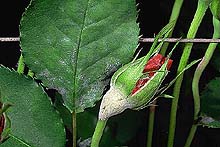
Fig. 1. The whitish powdery growth of powdery mildew is displayed on this bud and leaf (click image for larger view).
|
|
Rose varieties vary greatly in resistance to powdery mildew; landscape (shrub) rose varieties are among the most resistant. Glossy-foliaged varieties of hybrid teas and grandifloras often have good resistance to mildew as well. Plants grown in sunny locations with good air circulation are less likely to have serious problems. Fungicides such as triforine (Funginex™) are available but generally must be applied to prevent rather than eradicate infections, so timing is critical and repeat applications may be necessary. A commercial fungicide containing potassium bicarbonate (Kaligreen™) is also available. Commercial formulations of neem oil may also control powdery mildew. In home garden situations, sodium bicarbonate in combination with horticultural oils has been shown to control powdery mildew of roses when used in a solution of about four teaspoons of baking soda per gallon of water (about 6 cc baking soda per L water) with a one percent solution (v/v) of narrow-range oil. The best time to apply this solution to avoid problems with phytotoxicity is during cool weather. Sodium bicarbonate is deleterious to maintenance of soil pH and soil structure and may leave white foliar deposits, so numerous applications with resulting runoff should be avoided. This treatment may not be registered for use in commercial situations.
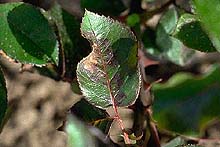
Fig. 2. Downy mildew causes interveinal, angular spots on leaves. If powdery growth is present, it is only on the underside of leaves (click image for larger view). |
|
Downy mildew, caused by the fungus Peronospora sparsa, requires moist, humid conditions. Interveinal, angular spots that are purple, red, or brown appear on leaves, followed by leaf yellowing and abscission (Fig. 2.). Fruiting bodies of the fungus occasionally may be observed on the undersides of leaves. Downy mildew can be reduced by increasing air circulation through pruning and avoiding frequent overhead irrigation. Control with fungicides is very difficult; environmental management is much more likely to be effective. Downy mildew is most likely to cause problems in wet subtropical or tropical areas or where rain has been frequent. Downy mildew is usually a springtime problem where it occurs.
Rust, caused by the fungus Phragmidium disciflorum, is favored by cool, moist weather. Infected plants have small orange pustules on the leaf undersides; the upper sides of leaves may discolor and leaves may drop (Fig. 3). Avoid overhead watering and prune back severely affected canes. During the winter collect and dispose of leaves remaining on the plants as well as those that have fallen off. Low levels of damage can be tolerated without significant losses. Preventive applications of fungicides can be used, but frequent applications may be needed and may not be justified in garden or landscape situations.
|
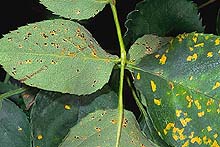
Fig. 3. Rust forms small orange pustules on undersides of leaves and may discolor upper leaves (click image for larger view).
|
|
Black spot, caused by the fungus Diplocarpon rosae, causes black spots to develop on the upper surface of leaves and stems. The spots have feathery or fibrous margins but no fungal growth on the undersides of leaves (Fig. 4). Small black fruiting bodies are often present in spots on upper sides of leaves. Miniature roses are more susceptible than other types. The fungus requires free water to reproduce and grow, so this disease may also be a problem during wet spring weather. If possible, rose foliage should not be allowed to remain wet for more than 7 hours. (Hose off aphids in the morning, so the leaves have a chance to dry by midday.) Provide air good circulation around bushes. Remove fallen leaves and other infested material and prune out infected stems during the dormant season. If required, fungicides (such as triforine) can be applied preventatively. Neem oil or a combination of sodium bicarbonate or potassium bicarbonate and horticultural oil as discussed under powdery mildew has also been shown to be effective for reducing black spot. Black spot is usually not a problem in arid climates like that of the southwestern U.S., but is common in wetter climates.
|
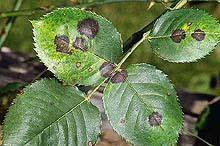
Fig. 4. Leaf spots caused by black spot have feathery margins and no fungal growth on undersides of leaves (click image for larger view).
|
|
Anthracnose, caused by the fungus Sphaceloma rosarum, causes spots on leaves. When first formed, the spots are red or sometimes brown to purple. Later the centers turn gray or white with a dark red margin. Fruiting bodies may appear in the middle of the spot, and the lesion may fall out, creating a shot hole symptom. No information on management is available. Hybrid teas and old-fashioned climbing and rambler roses are most often affected.
|
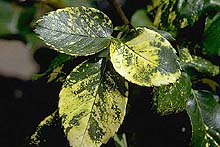
Fig. 5. Mosaic viruses cause splotches or zigzag patterns on leaves (click image for larger view). |
Viruses, including rose mosaic virus and others, may infect rose plants, although damage may be mostly cosmetic with little reduction in plant vigor (Fig. 5). Mosaic viruses can cause a variety of yellow zig-zagging patterns, splotching, or vein clearing. Symptoms are most pronounced in spring but may disappear almost completely during summer. Rose leaf curl virus causes leaves to curl downward and die, often with some overall yellowing. There is no known treatment for eradicating viruses in established plants. Tolerate or destroy infected plants and obtain virus-free stock for future planting. Because mosaic viruses are spread through propagation of plant parts, obtaining clean planting stock is the primary management strategy.
Nutrient deficiencies cause specific symptoms. Nitrogen deficiency causes chlorosis and drop of older leaves (Fig. 6). Since many soils have low concentrations of available nitrogen, roses may benefit from addition of this nutrient either as fertilizer or from organic material. Micronutrient deficiencies, especially iron and zinc, appear as interveinal chlorosis of new leaves. These elements may be deficient because soils are too wet, are too alkaline, or are soil types such as sandy loam, which have a low content of micronutrients. Because inorganic forms of iron and zinc form insoluble precipitates in alkaline soils, iron and zinc may be applied directly to foliage. Iron and zinc in a chelated form may be applied to either soil or foliage.
|
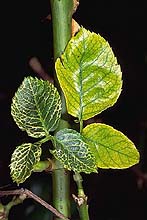
Fig. 6. The leaflet at left shows vein clearing caused by a virus. The leaf at right has veins that are green with yellowed interveinal areas caused by nitrogen deficiency (click image for larger view).
|
|
Nutrient excesses may limit rose growth if the total salt level becomes too high, above 2 dS m-1, which results in lack of vigor and short shoots, although no definitive leaf symptoms may occur. A few nutrients cause specific toxicities. Boron may be found in excess in western U.S. soils, causing stunting of plants, chlorosis, and marginal necrosis of newest leaves.
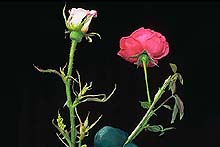
Fig. 7. The needlelike new leaves and underdeveloped blossom on the rose at left were caused by glyphosate (Roundup) damage (click image for larger view).
|
|
Herbicide damage may appear as a variety of symptoms, including cupped, curled, or chlorotic leaves, small leaves, or necrosis of the entire plant. The herbicide class and the dosage to the plant determine which symptoms appear and their severity. Injury from glyphosate (Roundup) is relatively common (Fig. 7). Damage symptoms caused by this herbicide may not appear during the season of application, especially if application is made in autumn, but symptoms may appear the following spring as a proliferation of small shoots and leaves from buds. The plant will outgrow the injury if the dosage was not too high. Glyphosate can be absorbed through green wood of canes, so care must be taken to avoid accidental application or drift.
Flower Petal and Bud Diseases and Disorders
Botrytis blight, caused by the fungus Botrytis cinerea, is favored by high humidity (Fig. 8). Affected plants have spotted flower petals and buds that fail to open, often with woolly gray fungal spores on decaying tissue. Twigs die back and large, diffuse, target-like splotches form on canes. To help control botrytis blight, reduce humidity around plants by modifying irrigation, pruning, and reducing ground cover. Remove and dispose of fallen leaves and petals. Prune out infested canes, buds, and flowers. Botrytis is usually a problem only in wet climates or during periods of wet weather.
|
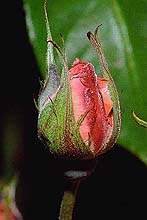
Fig. 8. The dark streak, gray spores, and decaying tissue on this blossom were caused by the fungus Botrytis cinerea (click image for larger view). |
|
Cane Diseases and Disorders.
For Botrytis blight, see above
Stem cankers and dieback can be caused by a number of different fungi. Cankers are often brown to deep purple or black, often with gray centers or small, black, spore-producing structures on dead tissue. Provide proper care to keep plants vigorous. Prune out diseased or dead tissue, making cuts at an angle in healthy tissue and just above a node. Avoid wounding canes. Cankers often develop after cold-weather injury, so early spring pruning may not effectively eliminate them if late frosts occur, and additional late spring pruning may be necessary.
Winter injury from cold temperature results in dead or dying flowers, twigs, and stems. Roses may be protected over the winter with a thick layer of leaf mulch in areas with winter minima below about 10F (-12C) without snow cover or about -10F (-23C) with snow cover. Winter injury may be followed by stem canker diseases caused by weak pathogens that move into injured tissue. Winter injury may also occur in mountain areas where late frosts affect developing tissue.
Sunburn appears as blackened areas, especially on the south and west sides of canes. Sunburn is caused by excessive temperatures on rose canes, usually as an indirect result of defoliation caused by drought stress or spider mite pressure. Reflected heat from masonry, vinyl siding, or rock mulch may also cause canes to sunburn. As would be expected, sunburn is uncommon in high latitudes, becoming more frequent in warm, sunny climates.
Crown gall, caused by the bacteria Agrobacterium tumefaciens, affects many woody plants, including fruit trees, ornamentals, and roses, as well as some herbaceous plants including chrysanthemums and daisies. Crown gall bacteria invade tissue following wounding. Galls, in the form of large, distorted tissue growth, form at the base of the plant or sometimes on roots or farther up on stems. Infected canes can be stunted and discolored. Do not plant roses in infested soil or near infested plants, and don’t transplant “gift” roses having questionable appearance of wood. Purchase and plant only high-quality roses.
Additional Resources
University of California Statewide Integrated Pest Management Project
The American Rose Society
2002: The Year of the Rose, from The American Rose Society
American Rose Center - Gardening tips
Rose Forums at GardenWeb
National Biological Information Infrastructure, from the US Geological Survey
Every Rose, "The Rose Reference Database"
The accompanying APSnet Feature is an excerpt from the publication, "Healthy Roses: Environmentally Friendly Ways to Manage Pests and Disorders in Your Garden and Landscape," University of California ANR Publication 21589. The complete publication can be ordered online at the University of California's Agriculture and Natural Resources online catalog. All photographs are copyright Regents of the University of California.
References
Dreistadt, S. H. 1994. Pests of Landscape Trees and Shrubs. Oakland: University of California DANR Publication 3359.
Dreistadt, S. H. 2001. Integrated Pest Management for Floriculture and Nurseries: Oakland: University of California DANR Publication 3402.
Flint, M. L., and J. F. Karlik. 2000. Healthy Roses: Environmentally Friendly Ways to Manage Pests and Disorders in Your Garden and Landscape. Oakland: University of California ANR Publication 21589.
Horst, R. K. 1983. Compendium of Rose Diseases. St. Paul, MN: APS Press.
Karlik, J. and M. L. Flint. 1999. Roses in the garden and landscape: Diseases and abiotic disorders. UCIPM Pest Note No. 7463.
University of California Pest Notes for various pests of gardens and landscapes, online at http://www.ipm.ucdavis.edu.
